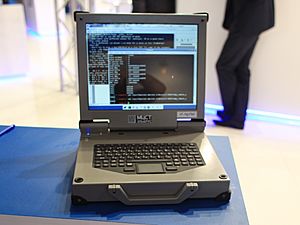MCST facts for kids
 |
|
| Joint-stock company | |
| Industry | Microprocessors |
| Founded | 1992 |
| Founder | Boris Babayan |
| Headquarters |
,
Russia
|
| Revenue | $25 million (2017) |
|
Operating income
|
$1.34 million (2017) |
| $911,252 (2017) | |
| Total assets | $54 million (2017) |
| Total equity | $6.15 million (2017) |
MCST, which stands for Moscow Center of SPARC Technologies, is a Russian company that makes special computer parts called microprocessors. It was started in 1992. MCST's processors are used in many devices, like personal computers, powerful servers, and other computing systems.
They design microprocessors using two main types of "languages" or designs: Elbrus and SPARC. MCST grew out of an older, very important research center called the Lebedev Institute of Precision Mechanics and Computer Engineering. MCST also works closely with the Moscow Institute of Physics and Technology, helping with their computer engineering studies.
MCST is known for developing the Elbrus processor design. This design is used in a family of powerful microprocessors. The name "Elbrus" is also a clever way to say "ExpLicit Basic Resources Utilization Scheduling."
In June 2024, a new processor called the "Elbrus-2S3" became available again in Russia. This processor has nine cores, which means it has multiple parts working together to handle different tasks. It was made using a 16-nanometer process, which refers to how small and advanced its parts are. This "Elbrus-2S3" is a smaller version of the 16-core Elbrus-16S processor.
In December 2024, special computer controllers called "PLC-Elbrus" were officially approved in Russia. These controllers use the Elbrus-2S3 microprocessor. They are made by a company called "Rostec Electronics." Because they are officially registered, these devices can be used in important computer systems that control things like power plants or factories.
Contents
MCST's Computer Products
MCST has developed many different processors and computer systems over the years. Here are some of the most important ones:
Early Elbrus Computers
- Elbrus 1 (1973) was a very early Soviet computer. It was designed by Vsevolod Burtsev. This computer used a special way of handling data and could use the ALGOL programming language.
- Elbrus 2 (1977) was a supercomputer with 10 processors. It was considered the first Soviet supercomputer. It was a faster version of the Elbrus 1.
- Elbrus 3 (1986) was a computer with 16 processors. It was designed by Boris Babayan. This computer used a different and very advanced design called VLIW (Very Long Instruction Word).
SPARC-Based Systems
- Elbrus-90micro (1998–2010) was a series of computers that used SPARC processors. These processors included models like the MCST R80, R150, R500, R500S, MCST-4R (MCST-R1000), and MCST-R2000. They ran at different speeds, from 80 MHz up to 2000 MHz.
Modern Elbrus Processors
- Elbrus-3M1 (2005) was a computer with two processors. It used the Elbrus 2000 microprocessor, which also had the VLIW design. It ran at 300 MHz.
- Elbrus МВ3S1/C (2009) was a computer with four processors. It used the Elbrus-S microprocessor and ran at 500 MHz.
- Elbrus-2S+ (2011) was a dual-core (two-part) processor. It was based on the Elbrus 2000 design and ran at 500 MHz. It could perform 16 billion calculations per second (GFlops).
- Elbrus-2SM (2014) was another dual-core processor. It ran at 300 MHz and could do 9.6 billion calculations per second.
- Elbrus-4S (2014) was a quad-core (four-part) processor. It ran at 800 MHz and could do 50 billion calculations per second.
- Elbrus-8S (2014–2015) was an octa-core (eight-part) processor. It ran at 1300 MHz and could do 250 billion calculations per second.
- Elbrus-8SV (2018) was also an octa-core processor. It ran even faster at 1500 MHz and could do 576 billion calculations per second.
- Elbrus-16S (2021) is a powerful 16-core processor. It runs at 2000 MHz. It can perform 750 billion calculations per second for some tasks and 1.5 trillion calculations per second for others.
- Elbrus-32S (planned for 2025) is a future processor with 32 cores. It is expected to run at 2500 MHz and perform 1.5 trillion calculations per second.
More Information
- History of computing in the Soviet Union
- Information technology in Russia
External Links
- Elbrus website in Russian
See also
 In Spanish: MCST para niños
In Spanish: MCST para niños


